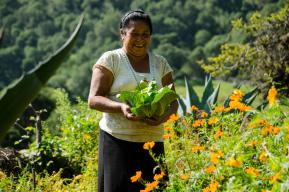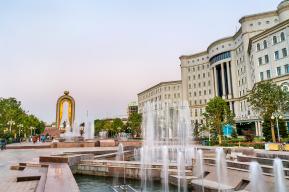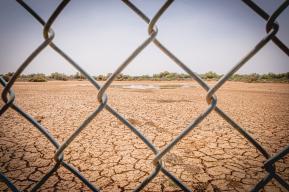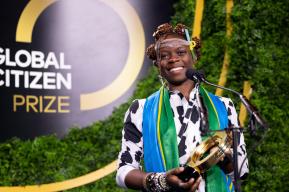St Mary's Biosphere Reserve is an important site in terms of biological diversity, comprising cloud forests, mangroves and coral reefs. It received the UNESCO designation in 2011. Located on the island of St Kitts, it is composed of a vast marine area, long and narrow forested ridges and agricultural hills. However, 32% of the total land area presents degradation. According to a 2019 assessment from UNCCD, main drivers are associated with deforestation, over-grazing, unregulated settlements and poor agricultural practices, among others.
To boost reconciliation between people and nature in the region, St Mary's Biosphere Reserve is the first UNESCO-designated site to benefit from the expertise of volunteer scientists from the UNESCO Earth Network project. The primary objectives are to gather key data to implement an ecological restoration plan and identify opportunities for sustainable livelihoods.
Challenges
Like many Caribbean islands, the socio-economic history of St Kitts and Nevis was marked by a heavy reliance on the lucrative sugar trade. Thanks to governmental efforts to diversify the economy since 1970s, the federation moved towards the development of tourism, bringing unprecedented opportunities to improve the livelihood of locals. However, when the tourism industry was brought to an almost complete halt between 2020 and 2021, St Kitts and Nevis saw a 14.5% drop in its GDP, followed by another 4.3% contraction in 2021.
As a Small Island Developing State (SIDS), St Kitts and Nevis have other reasons to improve its resilience, beyond a global pandemic. "These small island countries, by their very nature, face a number very serious challenges, which have been accentuated in the last decade by climate change, with more frequent and more violent natural disasters", affirms Ambassador David Doyle, Permanent Delegate of St Kitts and Nevis to UNESCO. In fact, while hurricanes and seismic activities are common phenomena in these islands across the Caribbean, the effects of climate change highlighted the need for restoring tropical forest shields and promoting resilient and biodiversity-friendly agriculture.
St. Kitts and Nevis needs to secure the expertise, funding and institutional capacity, which it lacks in sufficient magnitude, to deliver on the Sustainable Development Goals. I believe the work with the Earth Network will be a major step to strengthen our capacity in biodiversity conservation.
Like everyone else here in the community, I grew up eating turtle meat and eggs, until the day I saw with my own eyes a leatherback turtle laying her eggs on the beach and learned that it takes at least 30 years for a turtle to mature and come back here to lay other eggs. That image and that information has stayed with me forever.
The first mission of UNESCO's Earth Network
Generously supported by the Government of Italy, the Earth Network is a project that matches the ecological restoration challenges of UNESCO-designated sites with the expertise of senior and young scientists. It sponsors scientific missions to UNESCO-designated sites needing expertise on ecological restoration, namely biosphere reserves, UNESCO Global Geoparks and World Heritage sites.
The first beneficiary of the project, and the only small island developing state (SIDS) chosen as a pilot exercise, the St Mary's Biosphere Reserve listed the objectives it aimed to achieve with the technical expertise and support of the Earth Network volunteer experts. They are to:
- Develop a biodiversity loss inventory, i.e., soil-erosion, tropical forest depletion, diminished mangrove cultivation, extent of fauna and different species of birds, bees and other pollinators etc.
- Conduct an analysis of potential opportunities for employment based on sustainable, biodiversity-friendly agriculture practices and tools, i.e., better use of tropical forests as sources of new fruit and vegetable cultivation, and introducing new seed varieties more tolerant to heat and drought; and
- Examine opportunities for the creation of small enterprises associated with sustainable use of natural resources and biodiversity.
To collect data, assess the situation and start the work with local stakeholders, the Earth Network assigned a volunteer expert, Dr Haydi Berrenstein, who after extensive preparatory work since December 2022, conducted the first field mission from 20 to 24 February 2023.

During this first period, Dr. Haydi Berrenstein conducted a first round of data collection, exchanging with local experts, and interviewing different stakeholders.
A second mission took place in August 2023, when the volunteer expert of the Earth Network and the members of the local community worked together to formulate technical advice toward an ecological restoration plan in line with available good practices and assess feasibility for an inventory of local biodiversity.
The knowledge generated through Earth Network scientific missions around the world will be consolidated and widely disseminated in capacity-building activities (such as massive online open courses, webinars and workshops) and included in the upcoming UNESCO Biodiversity Portal, which will feature real-time data from UNESCO-designated sites, as well as top-notch solutions.
The initiative addressed specific challenges associated with agricultural practices, tools and methods of the St. Mary’s Biosphere Reserve site: cultivation, preservation and monetization of sustainable and biodiversity-led agriculture processes.
A plan to improve their practices started to be implemented in August 2023, through the development of a Seed Bank, the making of natural fertilizers and a whole Biodiversity Agricultural Reforestation plan. The overall aim is to embrace better use of tropical forests, enhance the cultivation of new fruits and combat soil erosion.
















